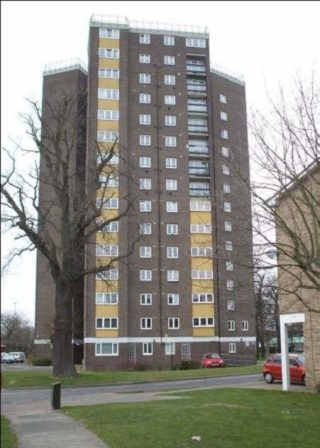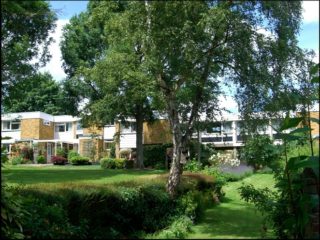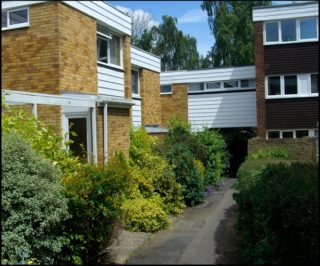5. The Commission for New Towns 1966-1978
By Joan Cobern, David Irving, Christine Martindale
On 1 April 1966 the Development Corporation was dissolved and its assets transferred to the Commission for New Towns (CNT). The CNT did not have the wide powers of the Development Corporation, particularly as regards compulsory purchase and, unlike the Corporation, had to apply to the Local Authority for planning permission. Local Committees were established by the Commission in each of the New Towns to manage the housing stock. They included members of local trade and voluntary services as well as local councillors and were expected to be broadly representative of the town as a whole.
One of the first acts of the CNT was to consider the future of the Old Town of Hatfield, the original village to the east of the railway. (Most of the original housing is covered in Part Ten of this series). A plan was produced by the new Chief Architect, Maxwell Fry, which effectively proposed the destruction of the bulk of the Victorian and early 20th century building and their replacement by new housing and shops, focussed on a new public square, Salisbury Square. Not everyone was happy with this wholesale gutting of the old town and the proposals went to public inquiry in September 1967. The scheme was ultimately given planning approval the following February and the whole area compulsorily purchased by the CNT in the March.
1967 also saw two pieces of new legislation which were to have an effect on the housing in the town. The first was the introduction of housing standards (the Parker Morris standards) which were intended to lay down minimum space standards, but which, in practice, soon became maximum standards. The other was the Leasehold Reform Act, which allowed lessees of residential properties to buy the freehold. When this was extended to all tenants under the Right to Buy scheme thirteen years later it was to have a profound effect on the visual appearance of the town.
1968 saw the second of the town’s multi-storey buildings. Goldings House (78 flats and maisonettes on 14 floors) was intended for single people and young married couples. An altogether more attractive building than Queensway House. Goldings House along with 128 three storey dwellings in Goldings Crescent and adjoining roads were designed by Woodroffe Buchanan and Coulter. Also in 1968 shops and offices with flats above were completed in White Lion Square, by Maxwell Fry, in a style which seemed to refer back to the earlier housing of the 1950s.
In December of that year the CNT received a report by Prof. J.B. Cullingworth into owner occupation in New Towns which found that there was an imbalance. The CNT then owned 4,000 residential units and Welwyn Hatfield Council 3,000. Cullingworth recommended that proportion of private housing in the town be increased from 17% to 26%.
This led the CNT to build 7 houses on Hertford Road in 1969, which it sold for £11,850 each. The adjacent site, between Hertford Road and Old Hatfield was then sold to Wates Ltd., for a development known as Park Meadow.
On the other side of the railway 11 individual building plots in Old French Horn Lane sold for £2,500 each. By 1971 12% of the housing stock had been sold to existing tenants, bringing owner occupation up to 27%.
Unlike the Development Corporation, the CNT did not work systematically, neighbourhood by neighbourhood. But, in line with their remit to maximise value from the assets, took a more opportunistic approach. When available land could be matched with an appropriate developer, the work went ahead, irrespective of where in the town it was. Consequently development occurred across the whole town through the 1970s:
1) 63 elderly persons Flats in Wellfield Road in 1971.
2) 135 dwellings on Glebelands in 1972.
3) 69 Flats over the top of the Woolco store in the Town Centre in the same year.
4) 25 houses and 9 flats in Batterdale, Old Hatfield by Rialto Homes in 1974.
5) 116 dwellings (60 flats and 56 houses) in Middlefield, The Paddocks and Oaktree Close, also in 1974.
The houses and flats in Middlefield, The Paddocks and Oaktree Close, built by Wates Ltd. were all originally for private sale. Due to a down turn in the economy only houses and flats in The Paddocks were sold privately, those in Middlefield & Oaktree Close were bought by the Circle 33 Housing Association and were occupied by tenants from London as well as from the local council waiting list. Shortly afterwards the Middleoak Tenants Association was formed due to an initiative by the Circle33. This Tenants Association through a committee was to manage the estate for the Circle 33. While there was some doubt that interest from tenants could be maintained, the MiddleOak Tenants Association managed the estate until 2009.
A milestone was passed in 1977 when the town’s population reached the Masterplan goal of 26,000. At that point the Government announced that the Commission for the New Towns was to be wound up as the controlling body for the First Generation New Towns (though it would continue to be responsible for the later New Towns), and its housing stock in Hatfield would be transferred to Welwyn Hatfield Council.









Add your comment about this page
Having grown up in Hatfield and done a bit of reading Focus etc I was led to believe that Park Meadow was built, or at least open for business, by 1966. A longstanding member of the local clergy had been among the first occupants and the date came from an interview with him in the parish magazine circa 1986. My parents bought a home there in 1970 when they moved down from Teesside.